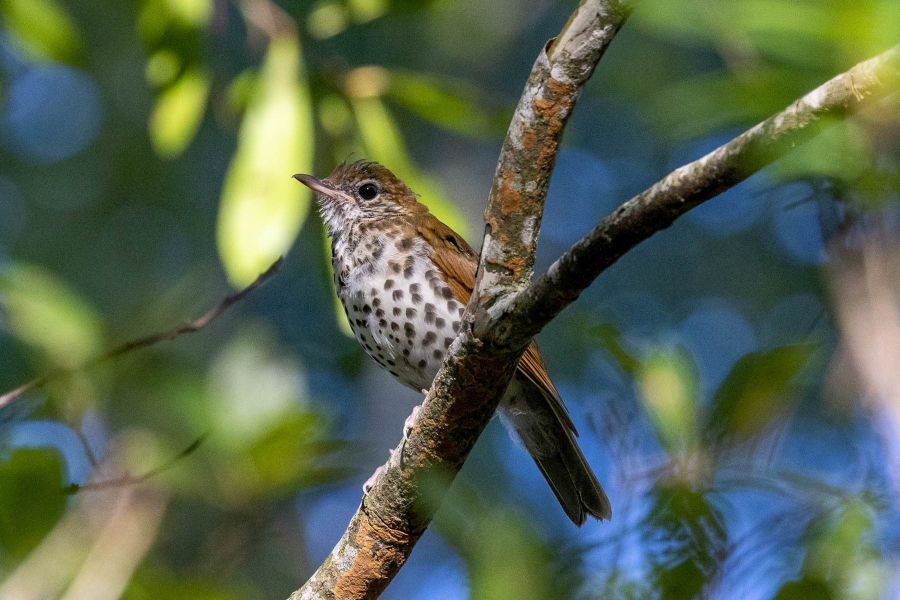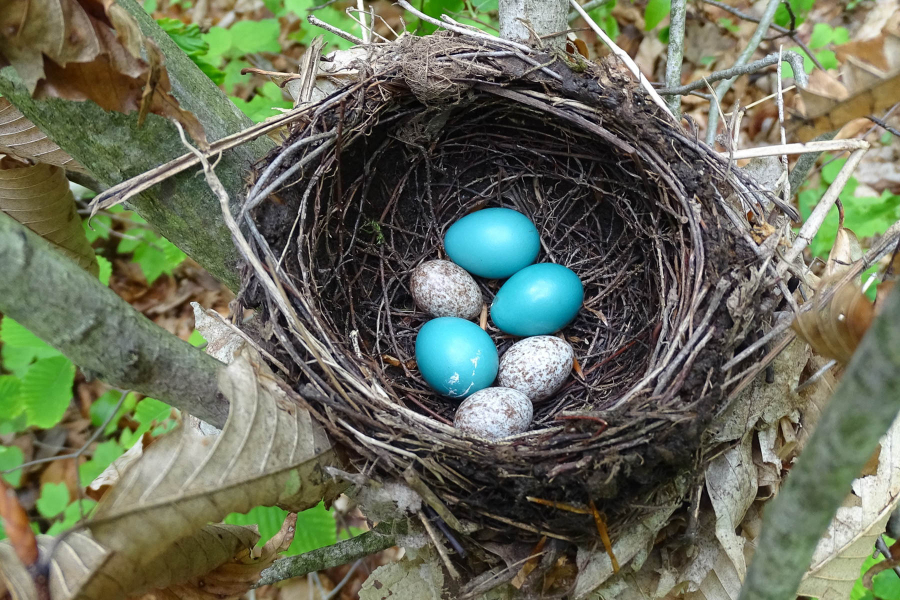Waking up with the wood thrush
Wood thrush—the official bird of Washington, D.C.—is known for its early song

It's 7 a.m. You wake up and decide to take a morning hike. As the sun rises over the horizon, you hear a captivating song coming from above. You look up into the nearest tree expecting to find a chorus of birds chirping in harmony. To your surprise, when your eyes focus to the nearest branch you see only a single bird, seeming to harmonize with itself.
Found throughout the Chesapeake Bay region, the wood thrush is one of nature’s most fascinating songbirds. With its y-shaped syrinx (otherwise known as its voicebox), the wood thrush can sing two notes simultaneously; commonly referred to as an “internal duet.” This is what allows one wood thrush to sound like more than one bird.
In its three-part song, wood thrushes perform this internal duet in the last part (or phrase) of the call. Although not as unique as the third, the first two phrases of the wood thrush’s song are also enchanting. The flute-like ee-oh-lay sound has both soft and high-pitched components. Certain notes that make up their songs are learned from other wood thrushes and added to the bird’s musical repertoire.
Along with robins, blackbirds and other species of thrush, the wood thrush is one of the first birds to perform their songs each morning. These songs are used to communicate, establish territory and help wood thrushes distinguish themselves from others.

During the breeding season—which typically begins in mid-to-late spring—the male wood thrush’s song becomes especially useful. After a long journey north from their winter migration, males are the first to arrive at their breeding grounds. In the several days prior to the female wood thrush’s arrival, the males use their song to designate their territory. In disputes, most breeds of songbird square off by song matching; a practice where one male mimics the song of another to prove that they perform it best. Wood thrushes, though, almost never song match. Instead, with their wide array of over 50 songs, males answer with a rival song to display their unique talents.
Apart from their song, this little bird has many other defining features. All wood thrushes—male, female and young—have white rings that circle their eyes. Wood thrushes are characterized by warm, cinnamon-colored feathers on their back and distinct brownish-black spots on their belly. While spotted bellies are common in many species of thrush, only the wood thrush’s spots are bold. Close relatives like the hermit thrush and swainson thrush have lighter-colored, smudged spots.

When they're not chirping in the trees, you can find wood thrushes hopping around on the forest floor searching for food. The wood thrush is particularly fond of soil invertebrates and larvae which typically reside under leaf litter. They use their beaks to overturn this litter in the hopes of uncovering their next meal. Although not its first choice, wood thrush will also eat seasonal fruit, insects, snails and small salamanders.
When the tables turn and the wood thrush becomes the prey, their beautiful voices turn aggressive. A wood thrush’s eggs are vulnerable to a variety of predators ranging from chipmunks and raccoons to crows and snakes, while owls and hawks prey on adult wood thrushes. When these predators are near, wood thrushes snap the parts of their bill together to create a siren-like distress signal that repels their aggressors.
Although the conservation status of this special songbird is stable, numbers are rapidly declining. Eliminating pesticide and herbicide use, and planting native trees are some of many ways that you can protect and promote wood thrush populations. As the national bird for Washington, D.C. and a testament to nature’s wonders, the wood thrush is a species worth saving.

Comments
We enjoyed participating in the cleanup event for Occoquan Bay done by CBF the year before last.
Interested in more about "Chesapeake Bay" birds
We fortunately live at the edge of a woodland patch, and this beautiful and musical bird occasionally visits the feeder, where we use a 'woodpecker mix' containing dried fruit.
Thank you!
Your comment has been received. Before it can be published, the comment will be reviewed by our team to ensure it adheres with our rules of engagement.
Back to recent stories